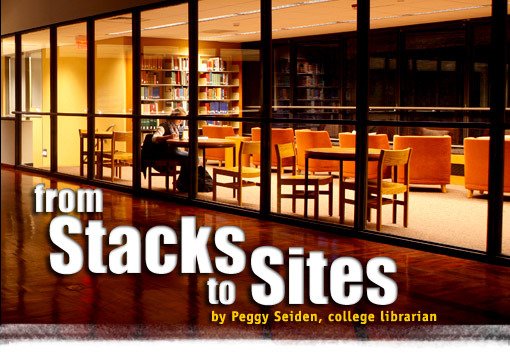From Stacks To Sites


College Librarian Peggy Seiden has long loved books and she is an early adopter of technology. She chose to go to Rutgers for library school in part because they were on the leading edge of the then developing field of information services. Today, you may find her poring over a medieval manuscript or catching up on the latest NYTimes headlines on her iPhone. You can reach her at pseiden1@swarthmore.edu
I am often asked whether I think the library will disappear in the next few decades. If we define "the library," as a place that collects, houses, preserves and provides access to books, journals, music or video and other information, then my reply is that the library may not go away, but it will be significantly transformed. There is little doubt that within the next 10 or 15 or 20 years, the association of "library" with tangible objects — be they books, journals, or audio or video recordings — will be meaningless to the vast majority of information consumers. For those of us who work in libraries, it feels as if we are going through an existential crisis.
A year ago, I would have said that as long as we continued to share with and instill a love of books and reading in our children, printed books would continue to be the preferred format for reading. As such, print culture would continue to thrive and with it libraries. Now, I'm not so sure.
Several weeks ago, at a Wednesday faculty lunch, 5 or 6 of the people seated at my table each took out their iphones and began discussing how they were using them to read newspapers, books, watch film clips, and basically stay informed. I was among those enthusiastic users. I had recently downloaded the "Kindle" online book app and had used it to read a sample of new novel, before deciding whether or not to buy it. Though I still get the New York Times in print every day, I tend to read the headlines on my iphone.

Within a decade, it is likely that most materials will be available on-demand in digital formats. The concept of building print collections will become increasingly irrelevant.
A recent poll on our library's web site found that 30% of respondents read books on some sort of mobile device and an article in the November 19, Daily Finance web site, cited some 33% of students are comfortable reading online, though 70% still preferred print to online (down 5% from the previous year). It's likely that number who prefer print will continue to shrink as devices improve and costs decrease.
Within a decade, it is likely that most materials will be available on-demand in digital formats. The concept of building print collections will become increasingly irrelevant.
Today's academic library collections were developed primarily with faculty research and curricular needs in mind. Consequently, there is a high level of unique holdings among different college libraries. Student research has often been circumscribed by the library collection at their institution.
We are looking at a time in the not too distant future when students and faculty will have access to the majority of English language scholarly monographs through Google, the Hathi Trust and other mass-digitization projects (a minimum of 5 million volumes, but likely to grow). With access to digital libraries, the importance of on campus print collections will begin to diminish. Students and faculty will begin their research on the network level, scouring vast databases of content. Students, in particular, will continue to utilize those materials which are easiest to access.
Initially, these works may be the ones held by the local library or local consortia, but when researchers can easily download books to good e-reading devices or there are high speed print-on-demand stations that will bind and collate these works, the physical location of these texts will not matter to most. (NB: I'm not talking about collections that are unique to institutions such as those found in the Friends Historical Library or Peace Collection).
The change in reading habits is likely to happen at different rates depending on the type of book (most reference books are better suited to online than print) or subject area. At some point, maybe in 10 years, maybe sooner, the stacks full of printed books in libraries will be of negligible value to most information seekers. We have already reached this point with science journals where most use is entirely online to discrete articles. Certainly we can envision a time in the not too distant future when the vast majority of textual materials needed to support undergraduate research at an institution like Swarthmore will not only be acquired in digital form, but will be read in that form as well.
Economics will drive new models of acquisition. Rather than subscribing or purchasing materials to be used just-in-case, libraries will increasingly adopt pay-per-view models.

Economics will drive new models of acquisition. Rather than subscribing or purchasing materials to be used just-in-case, libraries will increasingly adopt pay-per-view models.
Of course, little of this material will be free, after all Congress has seen fit to extend the duration of copyright. Despite some major advances in open access publishing in scientific literature, free scholarly monographic materials will be limited to snippets of text and those works in the public domain. Libraries will continue to pay for these materials in order that their clientele can have relatively unimpeded access to resources. But digital technologies make it possible to purchase at time of need, rather than just-in-case.
This purchasing model is gaining in popularity as the cost of science, technology, and medical (STM) journals exceeds libraries' abilities to commit to annual subscriptions. It is no longer economically feasible to purchase materials that are used infrequently and online journals allow us to determine use quite readily. Today this model is used largely to provide access to STM journals and reference works where people can purchase an article at a time.
Certain ebook vendors are offering collections where the subscriber pays a fee each time a book is "borrowed" for more than 10 minutes. In some cases, the library has the option to purchase after so many loans or article downloads. I could imagine a similar model with respect to mass digitized book collections — the library might pay a modest amount for a general subscription to such a collection, but if someone wanted to download or print the entire work, there would be additional charges.
This vision of the future turns the library on its head. The library is no longer building a collection for posterity, but rather is providing access to specific materials to meet a specific need. Some of the information will be free, some the library will pay for and continue to own, and in some cases, the library will facilitate access for the researcher but it will not own the information in perpetuity. Effectively managing financial resources as this future develops will be one of the significant challenges of this transition.
The Transformation of the Library
There is currently a great deal of conversation among librarians about creating our own preferred future. It is our hope that libraries will remain central to the intellectual life of the academy, recognizing that the role of librarians will certainly change. Librarians will take on new responsibilities for archiving locally generated research data and participating in the development of tools for mining and exposing the data to others outside the institution. The emphasis on collection development will shift to digitizing and making available the institution's unique materials: institutional archives, rare books and manuscripts, collections of art and artifacts. Librarians will continue to organize content, but the work will shift away from classification and description towards the development of tools to customize and personalize the online information environment. The core work of librarians will continue to be focused on student learning and ensuring that students are prepared with the skills necessary to be life-long learners.

The core work of librarians will continue to be focused on student learning and ensuring that students are prepared with the skills necessary to be life-long learners.
But there is nothing intrinsic in these activities that speak to the library as place. The Swarthmore College Library is iconic because it is the embodiment of the most important values of the college - the pursuit of knowledge and the life of the mind. But one could argue that the library's iconic character derives from the fact that libraries are first and foremost home to the world's accumulated knowledge. It is a place students come to study, to learn, to create, to engage in the life of the mind, hopefully to be inspired, as well as to meet friends, drink coffee, and check Facebook. It is the laboratory of the humanist and many a social scientist.
While we may acknowledge that the Web has more "information," it does not inspire us in the way that the reading room of the New York Public Library does. I would argue that it is the physicality of the collections that imparts a "sacredness" to libraries and that sacredness is essential to the notion of "a library." So when these print collections disappear and are replaced by computers, multimedia environments, coffee bars, and different study environments, do we still call this a library? Will the library lose its essence if it loses its stacks?


